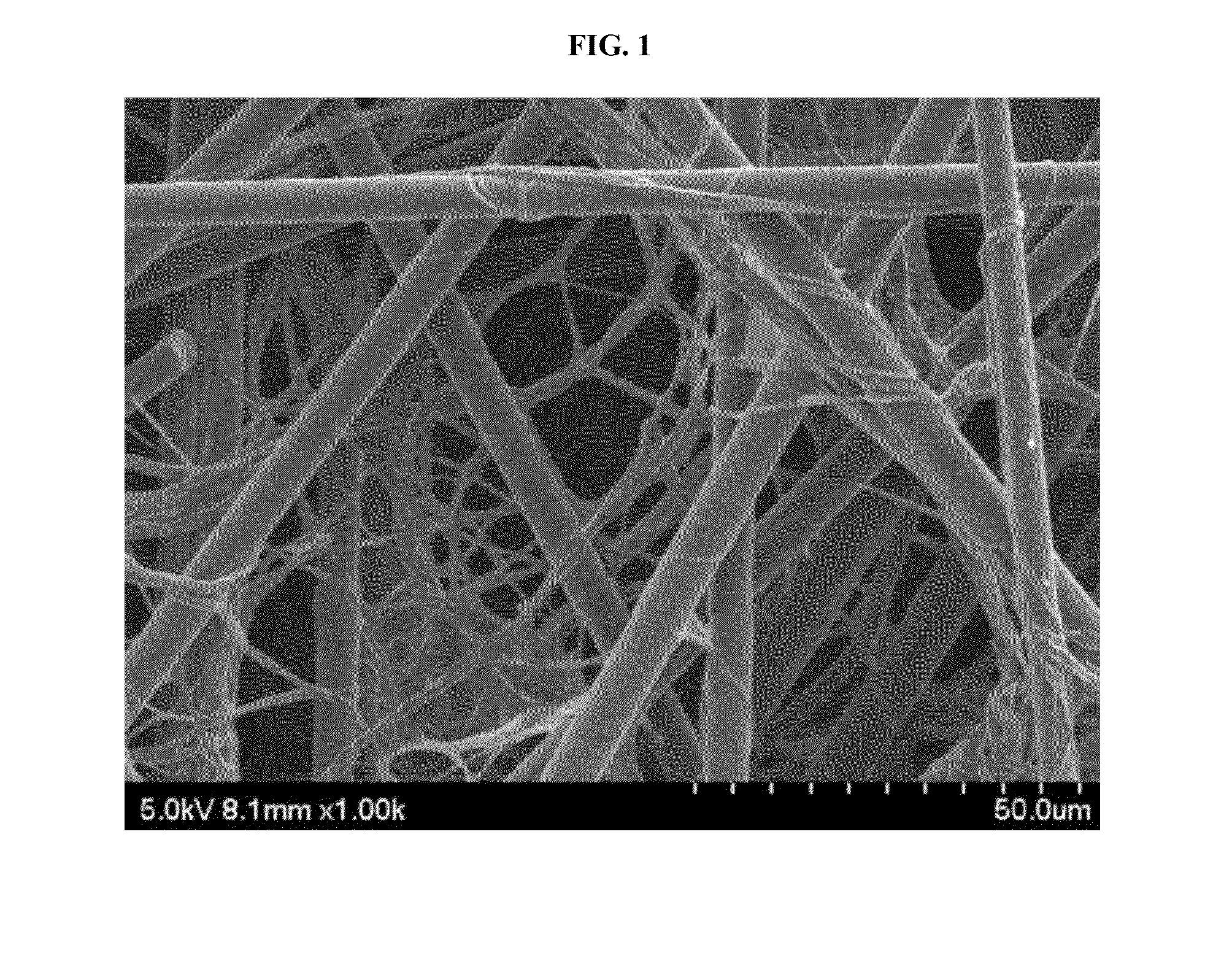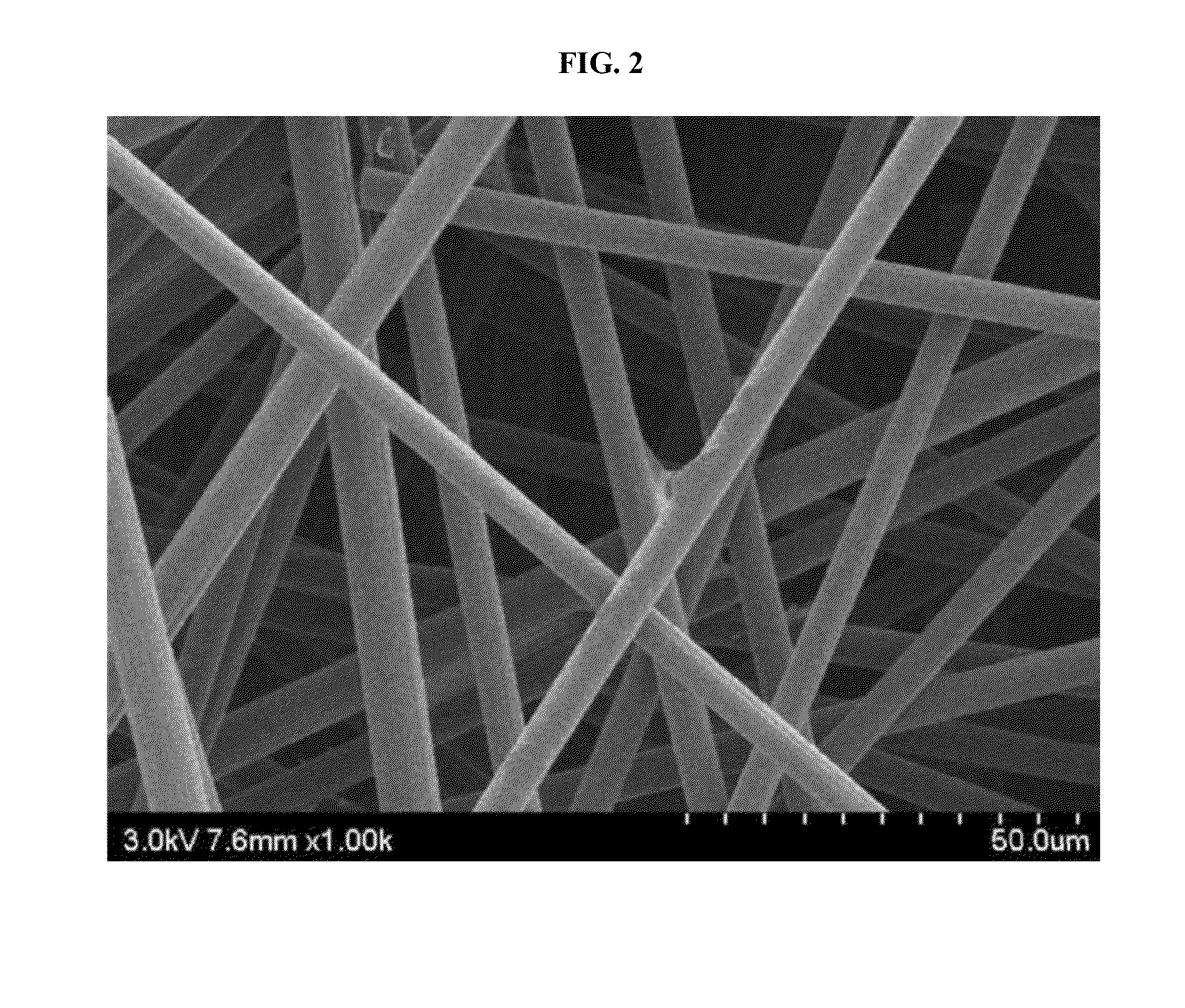Carbon fiber web including polymer nanofibers
a carbon fiber and nanofiber technology, applied in the field of carbon fiber webs, can solve the problems of insufficient tensile strength and carbon fiber webs, and achieve the effects of excellent flexural strength, gas permeability and electrical properties, and low thickness reduction ra
- Summary
- Abstract
- Description
- Claims
- Application Information
AI Technical Summary
Benefits of technology
Problems solved by technology
Method used
Image
Examples
example 1
Production of Carbon Fiber Web of the Present Invention
[0054]12 g of carboxymethyl cellulose (CMC) (FH1000, Korea Chemical Co., Ltd.) as a thickener was added to 2 liters of tap water in a beaker. The thickener was dissolved with stirring at 1,000 rpm for 30 min. The solution had a kinematic viscosity of 135 cSt. To the solution were sequentially added 2 g of 4.5 mm chopped carbon fibers (T-700, Toray), 0.3 g of 2.0 mm chopped polyvinyl alcohol as a binder, and 0.09 g of polyacrylonitrile (PAN)-based nanofibers (home-made). The mixture was stirred at 1,500 rpm for at least 2 h to prepare a slurry. Then, the slurry was poured into a wet paper forming machine (Sheet machine DM-831, Daiill Machine Industry) equipped with a triple-woven wire mesh (air permeability=345) at the bottom thereof, allowed to stand for 1 min, and dehydrated to obtain a carbon fiber web having a predetermined shape. The web was secondarily dehydrated using an absorbent paper, released from the absorbent paper, ...
example 2
Production of Gas Diffusion Medium of the Present Invention
[0058]The carbon fiber web produced in Example 1 was impregnated with a solution of a conductive graphite powder (MGF-4, Samjung C&G), a resol-type phenolic resin (KRD-HM2, Kolon), and methanol in a weight ratio of 1:1.4:8.6 for 5 min, and cured at 80° C. and 150° C. Subsequently, the cured product was carbonized by heating to 1,200° C. at a rate of 5° C. / min under a nitrogen atmosphere, and standing for 2 h. The amount of the carbon powder and the phenolic resin impregnated was 47.4 wt %, based on the total weight of the carbonized product.
experimental example 1
Measurement of Tensile Strengths
[0061]The tensile strengths of the carbon fiber web of Example 1, which was produced with the addition of the PAN-based nanofibers, and the carbon fiber web of Comparative Example 1, which was produced without the addition of the PAN-based nanofibers, were measured and compared. The results are shown in FIG. 5. The tensile strength measurements were done using a universal testing machine (H5KT, Tinius Olsen) according to T494, a test method for tensile strength of paper. The measurements were repeated 10 times in the same manner. The highest and lowest values were discarded and the other values were averaged. The graph of FIG. 5 indicates that the carbon fiber webs of Example 1 and Comparative Example 1 had average tensile strengths of 37.137 N / mm and 9.263 N / mm, respectively. That is, the tensile strength of the inventive carbon fiber web was about 400% higher than that of the prior art carbon fiber web.
PUM
| Property | Measurement | Unit |
|---|---|---|
| diameter | aaaaa | aaaaa |
| length | aaaaa | aaaaa |
| diameter | aaaaa | aaaaa |
Abstract
Description
Claims
Application Information
 Login to View More
Login to View More - R&D
- Intellectual Property
- Life Sciences
- Materials
- Tech Scout
- Unparalleled Data Quality
- Higher Quality Content
- 60% Fewer Hallucinations
Browse by: Latest US Patents, China's latest patents, Technical Efficacy Thesaurus, Application Domain, Technology Topic, Popular Technical Reports.
© 2025 PatSnap. All rights reserved.Legal|Privacy policy|Modern Slavery Act Transparency Statement|Sitemap|About US| Contact US: help@patsnap.com



